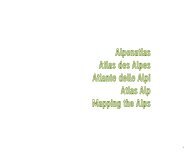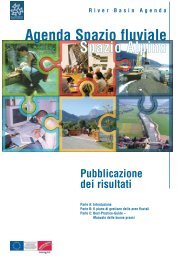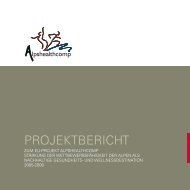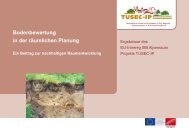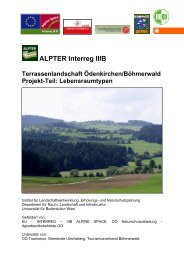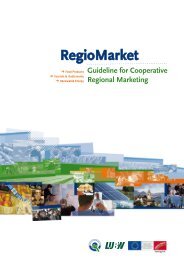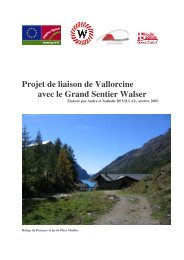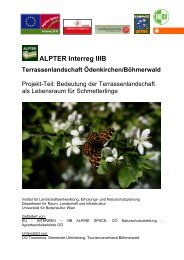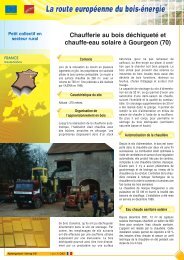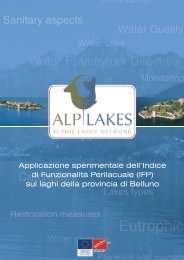WALSERSPRACHE - The four main objectives of the Alpine Space ...
WALSERSPRACHE - The four main objectives of the Alpine Space ...
WALSERSPRACHE - The four main objectives of the Alpine Space ...
You also want an ePaper? Increase the reach of your titles
YUMPU automatically turns print PDFs into web optimized ePapers that Google loves.
WALSER WÖRTERBÜCHER – LUXUS ODER NOTWENDIGKEIT?<br />
Verständigung. Die Mundart kann nicht künstlich erhalten werden, auch<br />
nicht durch das Sammeln des Wortstandes. Mundart überlebt, wenn sie<br />
gelebt und erlebt wird.»<br />
***<br />
Walser dictionaries: a luxury or a need? Some ten years ago, in Italy, Austria and in<br />
Switzerland <strong>the</strong>re appeared three dictionaries: 1) «Ts Remmaljertittschu» under <strong>the</strong> auspices<br />
<strong>of</strong> <strong>the</strong> Walser Study Centre <strong>of</strong> Rimella, 2) <strong>the</strong> «Kleinwalsertaler Mundartwörterbuch» by<br />
Tiburt Fritz, Werner Drechsel and Karl Kessler and 3) <strong>the</strong> «Inschi Sprààch – ds Obarsàxar<br />
Titsch» by Maria Ettlin-Janka, published by <strong>the</strong> Pro Supersaxa Association. That put <strong>the</strong> number<br />
<strong>of</strong> dictionaries, or word lists, to ten, and all <strong>of</strong> that in just fifteen years. Since <strong>the</strong>n we have<br />
seen no new entries, except for specialised dictionaries, like <strong>the</strong> one devoted to buildings, by<br />
Volmar Schmid. One can well ask oneself, if it makes any longer any sense, at <strong>the</strong> onset <strong>of</strong> <strong>the</strong><br />
21 st century, when everyone is bent on learning one international language or ano<strong>the</strong>r, to<br />
justify <strong>the</strong> appearance <strong>of</strong> such dictionaries. Is it not <strong>the</strong> language <strong>the</strong>y preserve a museum<br />
piece? Is it not some lonesome language-lover’s play toy since, in <strong>the</strong> end, it contributes very<br />
little to our modern-day society? And when it comes to Walser, is it not more a dialect than a<br />
language we deal with? Here is a remark by Iso Camartin, a scholar and specialist in<br />
Romanic languages: «<strong>The</strong> Walsers are as much entitled to continue existing as <strong>the</strong>ir language<br />
is». This statement alone could justify a motion by <strong>the</strong> Walser Union to petition <strong>the</strong> UNESCO to<br />
recognise <strong>the</strong>ir language as a world heritage, something which would have an immense bearing<br />
on <strong>the</strong> three-language speaking Grey Canton region. <strong>The</strong>se are questions which nowadays,<br />
in this context and as Walser associations, we must ask ourselves, since <strong>the</strong> preservation<br />
<strong>of</strong> a language, and <strong>of</strong> a mo<strong>the</strong>r tongue in particular, is like a highly sensitive seismograph,<br />
which better than anything else keeps track <strong>of</strong> <strong>the</strong> social and cultural conditions <strong>of</strong> a given<br />
population. Do we have today a boring universal language? <strong>The</strong> Swiss dialectologist Simon<br />
Gfeller has defined dialects in his diary in such a strikingly appropriate way that his definition<br />
held <strong>the</strong> ground for over seventy years: «Our mo<strong>the</strong>r tongue is <strong>the</strong> magic mirror with<br />
which we may light our children’s way in life and in <strong>the</strong> world. If we keep this mirror crystalclear,<br />
it will afford <strong>the</strong>m well-contoured, powerful projections. If it is sombre and askant, it<br />
will evoke distorted thoughts, which will nei<strong>the</strong>r be powerful nor lasting. Children must be<br />
shown that a dialect is not sheer babble and chatter, but a true language whose qualities outstrip<br />
those <strong>of</strong> a literary tongue.» This stands to prove what an enormously important task dictionaries<br />
can and must take on. Independently <strong>of</strong> <strong>the</strong>ir number <strong>of</strong> speakers, <strong>the</strong>y show what<br />
a language is capable <strong>of</strong> and what an array <strong>of</strong> linguistic shadings a dialect can afford. More<br />
than just language snap-shots. <strong>The</strong> all-in-all ten dictionaries or word lists, which have thus<br />
far appeared, have taken on a mighty challenge. In <strong>the</strong>m dialects which were just spoken over<br />
a 700-year span, must be codified all <strong>of</strong> a sudden. It is new and it is a mighty undertaking.<br />
In <strong>the</strong>m languages, as far as can be, must be led back to <strong>the</strong>ir origins, inasmuch as one must<br />
record not only <strong>the</strong> words <strong>the</strong>mselves, but also <strong>the</strong>ir development, influences and changes<br />
along <strong>the</strong> way. So <strong>the</strong>se dictionaries are far more than mere snap-shots ins<strong>of</strong>ar as <strong>the</strong>y include<br />
112



